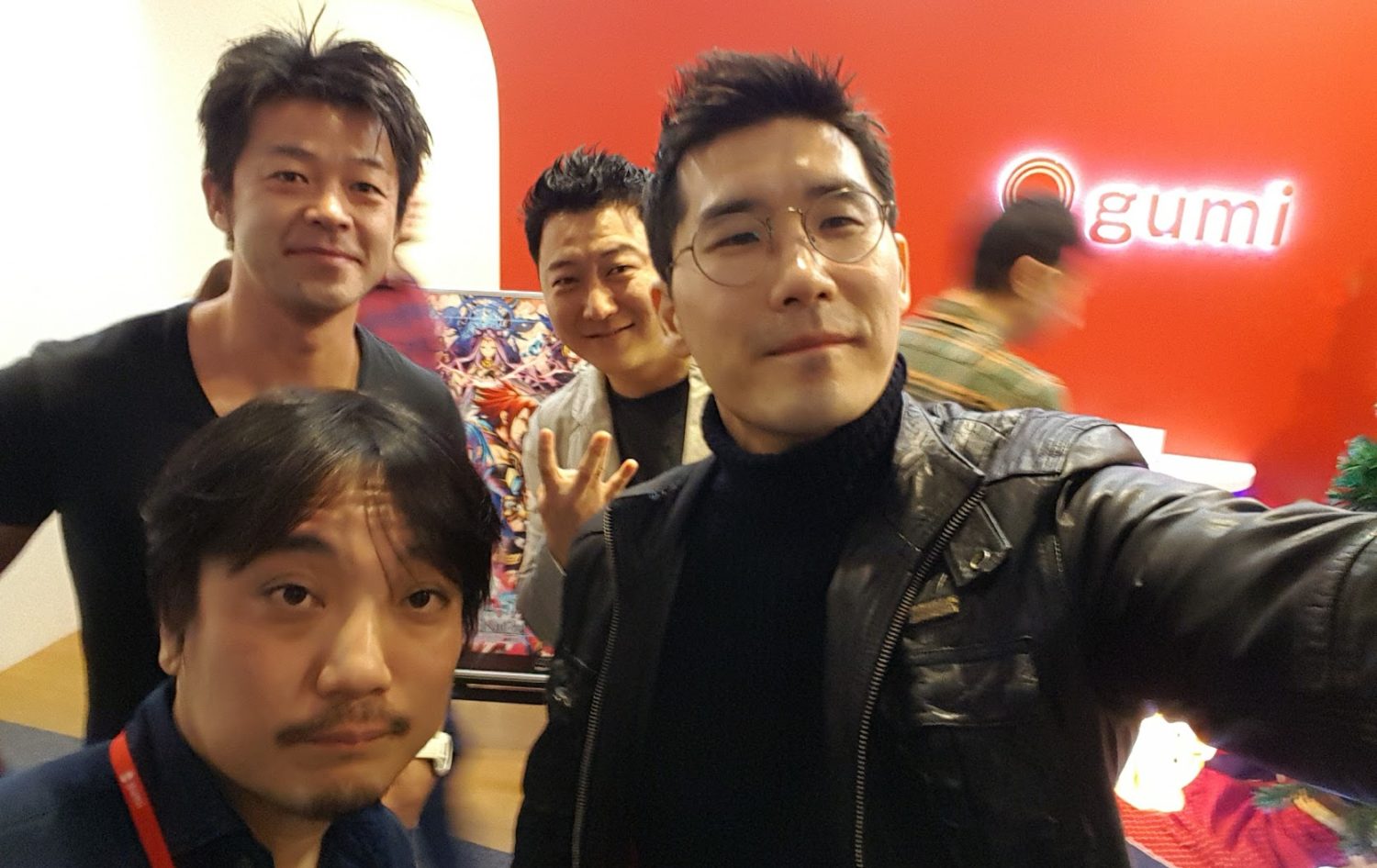Longevity
[Blog]
This is the same one I have here: Longevity
Post or Page, that is the issue (WordPress Posts vs Pages.) I don’t know. I originally had it is a Page. But then I wanted it as a Post… or both. I’m still to figure it out. (Hmmm… maybe Post then a Page. hmmm…)
Enjoy or not enjoy… I’m just experimenting here!
——-
My healthy diet – science-backed LONGEVITY healthy diet. 😉
It is a mixture of things, but it involves plant-based diet.
(Science and research always wins. Heh. )
- Whole Plant-Based Diet
- Blue Zones (www.Blue Zones.com/ Blue Zones Wikipedia )
- Blue Zones: I prefer the Okinawa Diet… because it the only one in Far East Asia. Ha!
- Blue Zones: It is the only one. Seventh Day Adventist diet, USA
I cut out the not-health ones. They are good, no question about that. I just wanted focus of health.
I spell it out here: Health… I never knew!
“Health
– Stroke (and Aphasia)
– Whole Food Plant-Based Diet/Nutritionist (that is the base)
– Fasting (intermittent fasting and long-term fasting)
– Longevity (I’m going to live past 100+ 150 years old!)
– Mediate
– Sleep”
Ok, here you go…
Whole Plant-Based and Aging
Mic the Vegan said it best:
Don’t have time to read? If you picked one, pick this one (Aging as we know it. Mic the Vegan). 😉
Blue Zones
“Inspired by the world’s longest-lived cultures…
live longer, better.
Longevity secrets, Blue Zones explorations, research and articles”
Blue Zones <– (website).

Scientists named the “Blue Zone” Giovanni Mario Pez, and Michel Poulain and research and scientist have since expanded the blue zones concept.
“Our work is rooted in The New York Times best-selling books “The Blue Zones,” “The Blue Zones Solution,” and “Thrive” – published by National Geographic books. We are now applying the tenets of “The Blue Zones” in 29 Blue Zones Project® cities throughout the U.S., significantly improving health and lowering healthcare costs.”
Dan Buettner is a National Geographic Fellow and multiple New York Times bestselling author. He has discovered five places in the world – dubbed “Blue Zones” – where people live the longest, and are healthiest: Okinawa, Japan; Sardinia, Italy; Nicoya, Costa Rica; Ikaria, Greece, and Loma Linda, California.
My friend never heard of that (Venture Capital, Harvard friend). He gave 2 sh#ts about the Blue Zones. Ha. But I like it, and screw him. (But does raise a question: How to prove scientifically without Blue Zones? Something need to think for a while. Argh! aphasia… you get 1 to 0.)
Anyway…
Here is a breakdown of 3 most targeted areas:
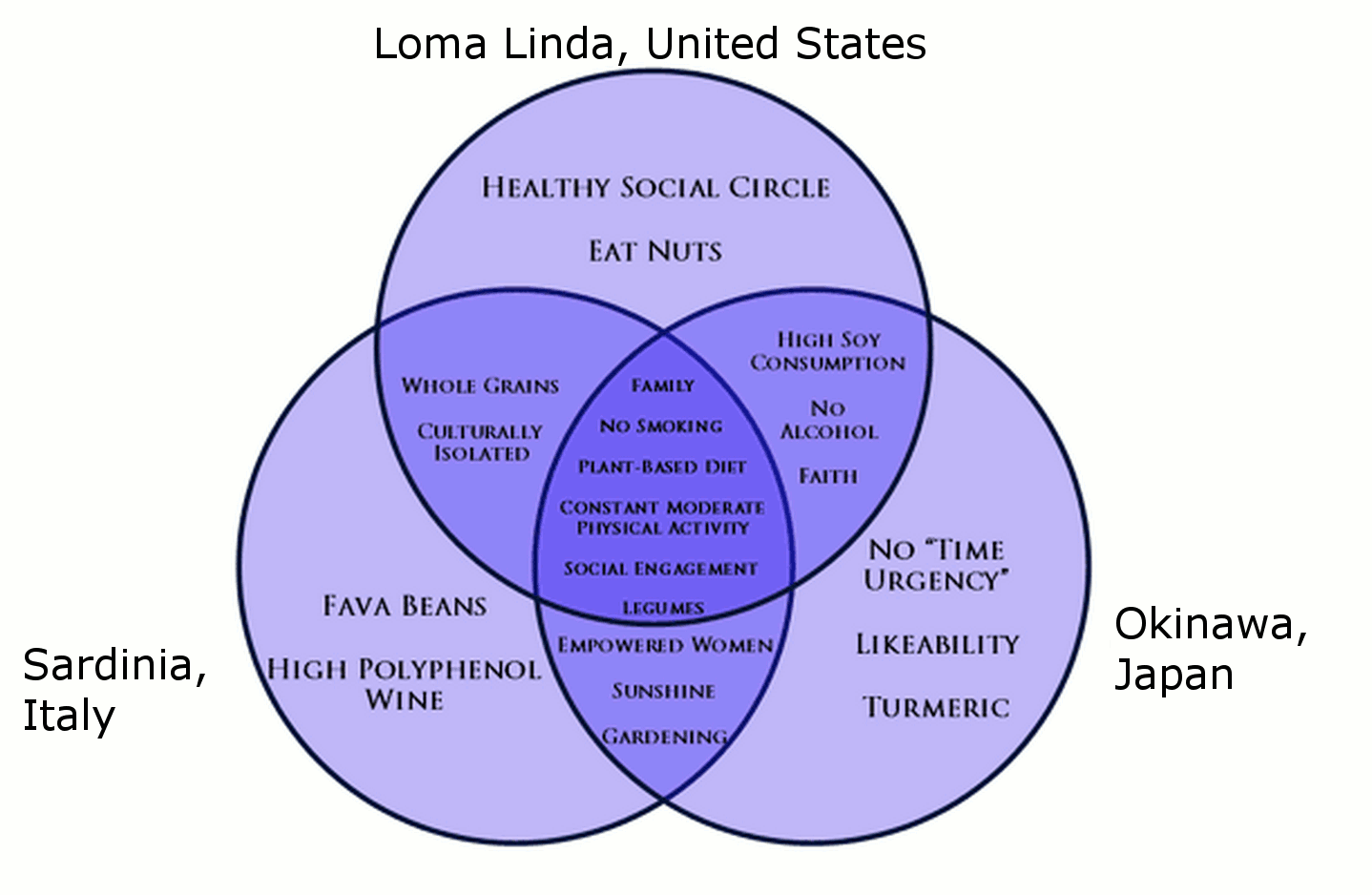
More proof. World Economic Forum. You have heard of that? (I’m given him sh#t. Relax. We are friends. Sheesh!)
World Economic Forum: 9 lessons from the world’s Blue Zones on living a long, healthy life
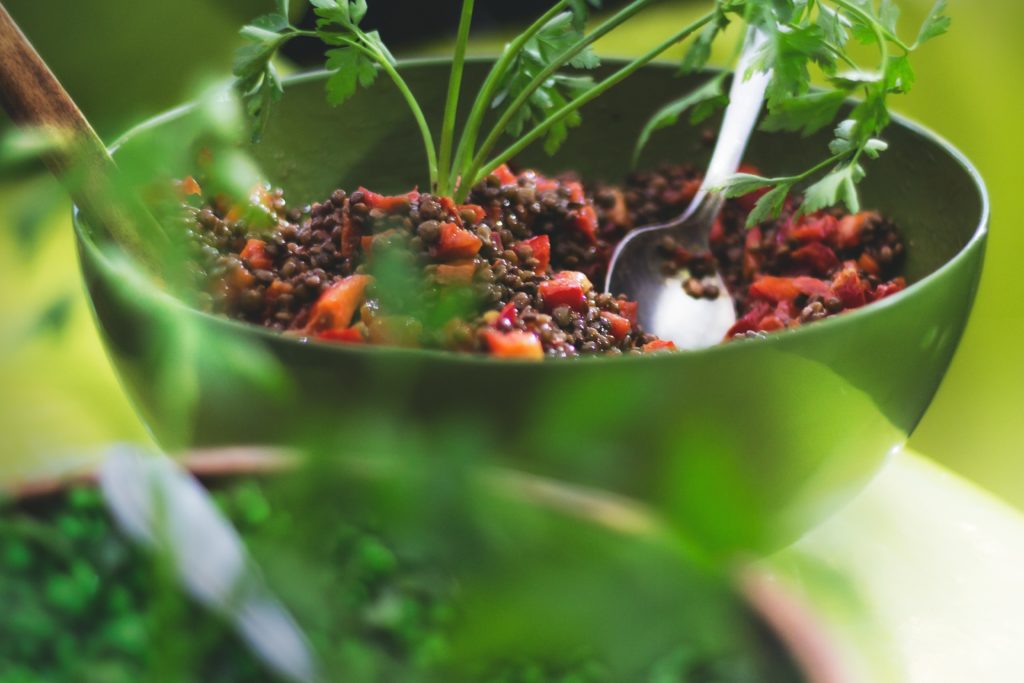
5. Plant Slant. Beans are the cornerstone of most centenarian diets. Vegetables, fruit, and whole grains round out the rest of the diet and meat is eaten in small amounts.
“By improving the places people live, work, learn, and play, we make it easier for people to move naturally, make new friends, and eat healthy.
The results have been dramatic. Albert Lea, MN was the first project city. In just one year, citizens added 2.9 years to their lifespans and healthcare claims decreased by 49%. Participating businesses saw a 21% decline in absenteeism.
…
Another Blue Zones Project city, Naples, FL, currently ranks first on the Gallup-Healthways Well-Being Index for 2016. There are currently 42 Blue Zone Project cities across the United States, and we continuously receive new applications from communities and cities all over the country that see the need to create lasting change.”
Traditional Okinawa Diet
But there’s one diet that modern researchers keep coming back to when they study health and longevity: the Okinawa diet.
(Tons of friends, mind you, Tech titans have given me sh#t for this! Aphasia… frustratingly ineffective when starting an argument! Argh! Let just say, ‘tradition style’ and ‘new style’ are different. The old is the Okinawa Diet – that is the one I am going for. ‘New style’ Okinawa diet is sh#t. Your talking McDonalds, pizzas and junk food is something I am not interesting in. That is the Western taking over the Eastern. I dive into that here: Health… I never knew and a not-finished-post. Haha.)
What Is the Okinawa Diet?
The Okinawa diet is named after the largest island in the Ryukyu Islands in Japan. History buffs might recognize the name from the Battle of Okinawa, fought during World War II. But these days, there’s another reason it’s in history books: Okinawa’s people live a really, really long time (and there are healthy up to the last day).
While the average life expectancy in the United States is 78.8 years, it’s 84 years old in Japan – and five times as many people from Okinawa live to be 100 years as their peers in the rest of the country. Researchers have studied the Okinawa’s residents for years, and the answer lies both in the typical Okinawan diet and the islands’ attitude toward eating.
Originally, it was more than 96% vegan
Did the Okinawans really eat lots of fish? How much meats and dairy were they eating before being influenced by the Westernized diet?
Based on the CDC Archives, here’s the data…

How and why do we know that? Because after World War II, the U.S. controlled Okinawa. It was returned to Japan in 1972.
In 1949, which was four years after the war ended, the daily diet of 2,279 average native Okinawans was analyzed and recorded (8). The results you see are reflected above and contrary to what the food pyramid allows, as you see the intake of fish, meat, eggs, and dairy each represented 1% or less of daily calories consumed.
It’s also worth noting that zero pickled vegetables were consumed. Lately, pickled cabbage and kimchee have been touted as superfoods by many health-oriented restaurants due to their probiotic content.
The data suggests that indeed, Okinawans did have lower rates of gastrointestinal cancer – 50% less than what was seen in mainland Japan, where pickling is quite popular.
Don’t even bother looking at more recent statistics for cancer rates or anything else for that matter. Why? Because the Okinawa menu today is more along the lines of burgers, pizzas, and fries. In fact, they went from being the skinniest people in Japan to the fattest…

We learned that fact thanks to Dr. Michael Greger. This also goes to debunk the belief that it is the Okinawans genetics which are causing them to live to 100 (or a long time) and be skinny. Since adapting the Western diet, not only are they fat, but their famed longevity benefits have now disappeared.
What following the diet REALLY looks like:
Pie chart of Okinawa diet foods by calorie intake
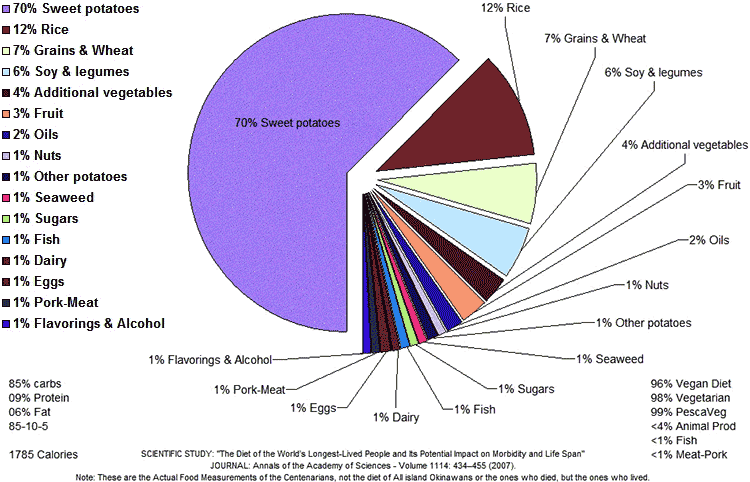
(Annual of the Academy of Science – Volume 1114: 434-455 (2007))
Yep, over 70% of their daily caloric intake is coming from purple yams.
Even though they’re high in carbs, purple sweet potatoes have a high ORAC value (meaning they’re rich in antioxidants). We are unaware of a reputable source for their glycemic index (GI) rating, but they are believed to be relatively low GI foods based on how the more common orange sweet potato performs.
The best modern version
We’re guessing that even if you could, you don’t want to rely on a basic purple yam recipe for 70% of your calories. Perhaps the best takeaways from an Okinawa diet is the following:
1. Lower glycemic, whole foods
Cutting out refined sugars as much as your willpower allows. For your carbs, choose those which are lower glycemic. This naturally entails less processed foods and more emphasis on whole foods with complex carbs.
2. Mostly plant-based diet
Going vegan doesn’t mean you will be 100 years old when you croak, but statistically speaking, the diets and cultures around the world who have had the highest number of centenarians were substantially more plant-based. With the Okinawa in particular, it’s also a low-fat diet which rarely involved oils.
3. Calorie restriction (or supplements to mimic?) [I do not take this method]
The Okinawans had a rule called “hara hachi bu” which meant you should only eat until you are 80% full. Their average number of calories consumed per day was only 1,785. They didn’t starve themselves though, actually quite the opposite, as the “featherweight” diet foods allow you to stuff yourself while consuming very few calories in the process.
A calorie restrictive diet like this is perhaps the only thing which has been proven to slow aging in numerous studies.
(Original script: www.superfoodly.com/okinawa-diet-plan-food-list-and-menu-recipes/)
Seventh Day Adventist Diet
One thing that is common is a blue zone studies is that eat predominantly a health plant-based food diet. In fact, one of the healthy sub-groups of blue zones are the vegans, who live in the adventists in Loma Linda, California, United States.
Seventh-day Adventists are encouraged to eat a well-balanced vegetarian diet. They avoid meat but eat legumes, whole grains, nuts, fruits, and vegetables. (But vegans are high among the group. Ha!) According to the Seventh-day Adventist website, “we believe God calls us to care for our bodies, treating them with the respect a divine creation deserves.
https://www.ncbi.nlm.nih.gov/pmc/articles/PMC4191896/
https://jamanetwork.com/journals/jamainternalmedicine/fullarticle/1710093


The Adventists are also notably resilient. “Some Adventists get personally offended if they get colon cancer or some other disease,” says a doctor from the town.
The death rate from cancer for Adventist men is 60 percent lower than that of the average California male; for Adventist women, it is 75 percent lower. According to Loma Linda University, ground zero in the Adventist Health Studies, “Death from coronary heart disease among Adventist men was 66 percent [lower compared to their California peers]; for Adventist women, it was 98 percent [lower]. Stroke death rates for Adventist men were 72 percent [lower], compared to their non-Adventist counterparts. For Adventist women, death from stroke was 82 percent [lower].”
These facts have led Buettner, a National Geographic Explorer, to label Loma Linda America’s hot spot (or “Blue Zone: Loma Linda“) of health and longevity. Their physical health is not the only thing outpacing that of regular Americans. On measures of mental health and well-being, the Adventists also score much higher than the average American.
(Original script: https://www.consultant360.com/n411/articles/seventh-day-adventist-diet-0)
That’s it. That is what I eat now.
I’m learning, but as of now, a largely, whole food plant-based diet.
And it is really goooooodd!!
Foods are plentiful (well, I’ll make them plentiful), and I have energy and I am athletic. (I’m working on it. F#ckin stroke!!!) But, dammn, I FEEL GOOD! Now, I just want to get over the stroke/aphasia. Arghhh!
No problem of getting over a 100 years old… screw it! I want a make over 150 old years! Ha!
Hey, one can dream. 🙂
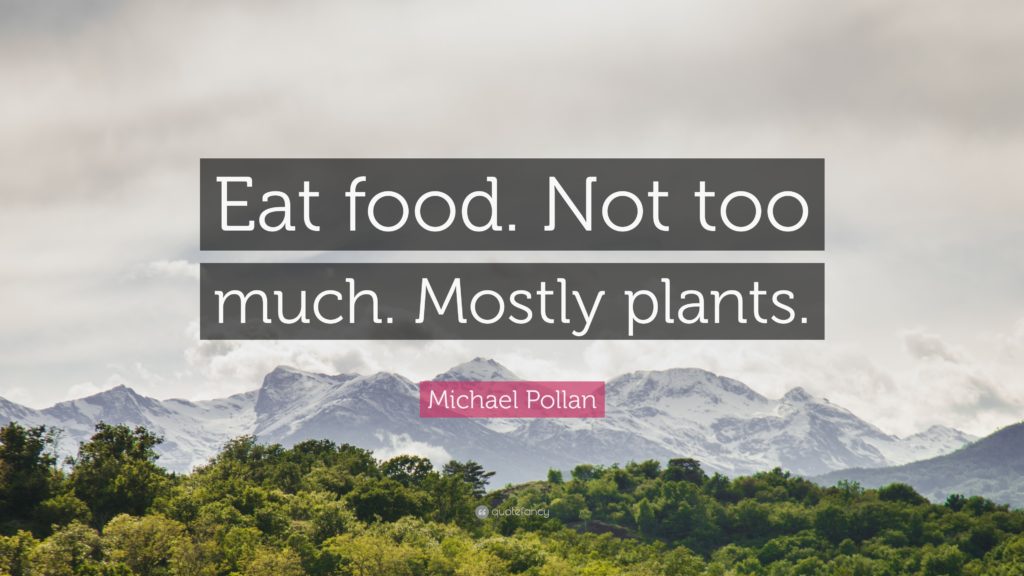
Eat wisely.
That is all I can say at this point.
🙂
This is the same one I have here: Longevity

